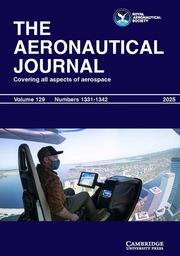No CrossRef data available.
Article contents
Challenges in emissions assessment for hybrid-electric regional aircraft
Published online by Cambridge University Press: 19 May 2025
Abstract
This paper investigates a method for estimating emissions from hybrid-electric aircraft, providing a qualitative assessment of their potential environmental benefits. Limited data availability poses challenges, discussed in this study, for its rigorous evaluation. Proper characterisation of both  ${{C}}{{{O}}_{{2}}}$ and non-
${{C}}{{{O}}_{{2}}}$ and non- ${{C}}{{{O}}_{{2}}}$ emissions across the operating envelope is crucial. Existing databases and predictive models for turboshaft engines for full-thermal regional aircraft may not be reliable for hybrid-electric configurations, which could operate under uncommon conditions, as low thermal power supply during specific flight phases. This uncertainty highlights the limitations of current emission prediction models. The first of the present study examines non-
${{C}}{{{O}}_{{2}}}$ emissions across the operating envelope is crucial. Existing databases and predictive models for turboshaft engines for full-thermal regional aircraft may not be reliable for hybrid-electric configurations, which could operate under uncommon conditions, as low thermal power supply during specific flight phases. This uncertainty highlights the limitations of current emission prediction models. The first of the present study examines non- ${{C}}{{{O}}_{{2}}}$ emissions (
${{C}}{{{O}}_{{2}}}$ emissions ( ${{N}}{{{O}}_{{x}}}$, HC,
${{N}}{{{O}}_{{x}}}$, HC,  ${{S}}{{{O}}_{{2}}}$, CO) from hybrid-electric aircraft optimised for minimum block fuel, comparing them with those from thermal competitors. The second part evaluates
${{S}}{{{O}}_{{2}}}$, CO) from hybrid-electric aircraft optimised for minimum block fuel, comparing them with those from thermal competitors. The second part evaluates  ${{C}}{{{O}}_{{2}}}$ emissions, considering both in-flight and electricity generation contributions. Results indicate that hybrid-electric configurations could reduce non-
${{C}}{{{O}}_{{2}}}$ emissions, considering both in-flight and electricity generation contributions. Results indicate that hybrid-electric configurations could reduce non- ${{C}}{{{O}}_{{2}}}$ emissions for both the entire mission and the landing-take-off cycle. However,
${{C}}{{{O}}_{{2}}}$ emissions for both the entire mission and the landing-take-off cycle. However,  ${{C}}{{{O}}_{{2}}}$ reductions are only significant for short design ranges and could be marginal if electricity generation does not shift to fully renewable sources.
${{C}}{{{O}}_{{2}}}$ reductions are only significant for short design ranges and could be marginal if electricity generation does not shift to fully renewable sources.
Information
- Type
- Research Article
- Information
- Copyright
- © The Author(s), 2025. Published by Cambridge University Press on behalf of Royal Aeronautical Society


